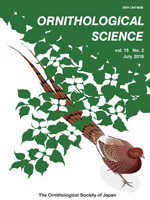Parent Procellariiformes alternate between long-range foraging trips to feed in distant productive marine areas and short-range trips to feed in less productive areas around their breeding colony. Foraging trip duration, diet, energy expenditure, and chick growth of Streaked Shearwaters Calonectris leucomelas were compared between two colonies, one on Mikura Island located in the warm and less productive waters of the Kuroshio current, and the other on Sangan Island located in the cold and more productive waters of the Kuroshio/Oyashio transition zone. Parent shearwaters breeding on Mikura alternated between short (≤3 days) trips to Kuroshio waters in order to provision their chicks and long (>3 days) trips to the cold Oyashio region in order to accumulate energy reserves for themselves. Shearwaters breeding on Sangan mainly took short trips (≤2 days) to the nearby Kuroshio/Oyashio transition zone, but also took longer trips (>2 days) to the cold Oyashio region. Parent shearwaters breeding on Mikura, however, made more frequent long trips (24%) than those breeding on Sangan (9%). Parents at both colonies commonly brought Japanese Anchovy Engraulis japonica and Darkedged-wing Flyingfish Cypselurus hiraii for their young, while parents on Mikura also brought Pacific Saury Cololabis saira and stomach oil after long trips. Parents on Mikura delivered energy at a lower rate, resulting in lower chick growth rates and smaller fledging masses than on Sangan. Unlike other Procellariiformes seabirds, shearwater parents on Sangan accumulate their own body reserves even during the chick rearing period because of better foraging efficiency than on Mikura. This may indicate that chicks were satiated by the meals delivered to them allowing parents to utilize the remaining provisions for their own body reserves.
BioOne.org will be down briefly for maintenance on 17 December 2024 between 18:00-22:00 Pacific Time US. We apologize for any inconvenience.
How to translate text using browser tools
1 July 2016
Dual Foraging Strategy and Chick Growth of Streaked Shearwater Calonectris leucomelas at Two Colonies in Different Oceanographic Environments
Daisuke Ochi,
Kei Matsumoto,
Nariko Oka,
Tomohiro Deguchi,
Katsufumi Sato,
Takashi P. Satoh,
Fumihito Muto,
Yutaka Watanuki
ACCESS THE FULL ARTICLE

Ornithological Science
Vol. 15 • No. 2
July 2016
Vol. 15 • No. 2
July 2016
colonial breeding
Energy intake
feeding behavior
foraging strategy
Marine environment




